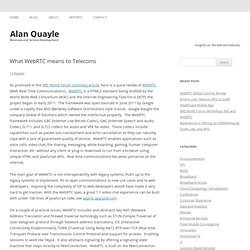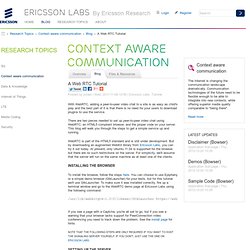

What WebRTC means to Telecoms - Alan Quayle Weblog. As promised in the IMS World Forum summary article, here is a quick review of WebRTC (Web Real Time Communications).

WebRTC is a HTML5 standard being drafted by the World Wide Web Consortium (W3C) and the Internet Engineering Task Force (IETF), the project began in early 2011. The framework was open sourced in June 2011 by Google under a royalty free BSD (Berkeley Software Distribution) style license. Google bought the company Global IP Solutions which owned the intellectual property. The WebRTC framework includes iLBC (Internet Low Bitrate Codec), iSAC (Internet Speech and Audio Coder), G.711, and G.722 codecs for audio and VP8 for video.
These codecs include capabilities such as packet loss concealment and echo cancellation so they can robustly cope with a lack of guaranteed quality of service. The main goal of WebRTC is not interoperability with legacy systems, that’s up to the legacy systems to implement. On the current status of browser implementations: WebRTC. A Web RTC Tutorial. With WebRTC, adding a peer-to-peer video chat to a site is as easy as child's play and the best part of it is that there is no need for your users to download plugins to use the service.

There are two pieces needed to set up peer-to-peer video chat using WebRTC: an HTML5 compliant browser, and the proper code on your server. This blog will walk you through the steps to get a simple service up and running. WebRTC is part of the HTML5 standard and is still under development. But by downloading an augmented WebKit library from Ericsson Labs, you can try it out today. At present, only Ubuntu 11.04 is supported for the browser, but there are no such restrictions on the server. Installing the Browser To install the browser, follow the steps here. /usr/lib/webkitgtk-1.0-0/libexec/GtkLauncher If you see a page with a Captcha, you're all set to go, but if you see a warning that your browser lacks support for PeerConnection video conferencing you need to track down the problem.
Setting up the Server. WebRTC 1.0: Real-time Communication Between Browsers. AddIceCandidate The addIceCandidate() method provides a remote candidate to the ICE Agent.

In addition to being added to the remote description, connectivity checks will be sent to the new candidates as long as the ICE Transports setting is not set to none. This call will result in a change to the connection state of the ICE Agent, and may result in a change to media state if it results in different connectivity being established. If the candidate parameter is malformed, throw a SyntaxError exception and abort these steps. If the candidate is successfully applied, the user agent MUST queue a task to invoke . If the candidate could not be successfully applied, the user agent MUST queue a task to invoke with a DOMError object whose name attribute has the value TBD (TODO InvalidCandidate and InvalidMidIndex). Note What errors do we need here? Return type: void addStream Adds a new stream to the RTCPeerConnection. When the addStream() method is invoked, the user agent MUST run the following steps: close.